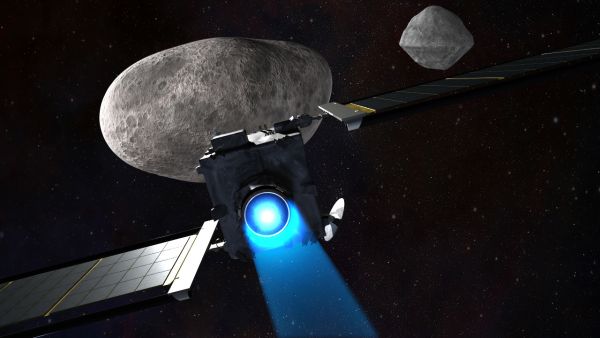NASA just redirected an asteroid by smashing a spacecraft into it
The test will help scientists learn how to stop catastrophic asteroid impacts.

NASA has intentionally slammed a spacecraft into an asteroid in the first ever test of Earth’s planetary defense system.
NASA’s Double Asteroid Redirection Test (DART) spacecraft smashed into the asteroid Dimorphos at 7:14 p.m. ET on Monday (Sept. 26) in humanity’s first attempt to alter an asteroid’s trajectory. NASA believes the impact will be a vital demonstration of how humans could one day nudge a dangerous asteroid away from a catastrophic collision course with our planet.
The 1,210-pound (550 kilograms) DART craft — a squat, cube-shaped probe consisting of sensors, an antenna, an ion thruster and two 28-foot-long (8.5 meters) solar arrays — made a direct hit with the 525-feet-wide (160 m) asteroid Dimorphos while traveling at roughly 13,420 mph (21,160 km/h) and dramatically disintegrated upon impact.
Related: What happened when the dinosaur-killing asteroid slammed into Earth?
"Now is when the science starts, now that we've impacted. Now we're going to see how effective we were," Lori Glaze, Planetary Science Division Director at NASA, said in a live webcast of the event.
The probe's goal was to slow the orbit of Dimorphos around its larger partner — the 1,280-feet-wide (390 m) asteroid Didymos. NASA will deem the mission a success if Dimorphos’s 12-hour orbit slows by 73 seconds, but the real change could be by as much as 10 minutes. Neither asteroid poses a threat to Earth. Data that will pour in for weeks to come will tell us how successful that mission was, said Nancy Chabot, Coordination Lead for the DART mission, in a live webcast of the event.
To arrive at the twin asteroids, DART undertook a 10-month, 7 million-mile (11 million kilometers) journey from its launchpad at Vandenberg Space Force Base in California, where it was launched aboard a SpaceX Falcon 9 rocket.
Sign up for the Live Science daily newsletter now
Get the world’s most fascinating discoveries delivered straight to your inbox.
DART’s final moments were captured by its onboard Didymos Reconnaissance and Asteroid Camera for Optical Navigation (DRACO), which automatically steered the spacecraft into its collision course with the distant asteroid. NASA scientists said that Dimorphos wasn’t even visible to DART’s DRACO camera system until it was within one hour of impact, after which it became just one pixel in the camera’s field of view. Three minutes prior to impact, the asteroid grew to just 42 pixels in size. As the craft approached Dimorphos, the rough terrain and shadowy boulders became bigger and bigger before the image blanked out.
The spacecraft’s camera then snapped the final images of its target — which can be seen here on NASA’s Youtube channel — mere moments before DART made contact.
Scientists will get a better picture of the impact’s immediate aftermath by turning to the Italian space agency's LICIACube — a smaller "cubesat" spacecraft that split from DART on Sept. 11. Orbiting the aftermath of the collision at a distance of 34 miles (55 km), LICIACube will beam photos back to Earth of the trajectory-altering impact and the plume of material thrown out by the crash. And now, telescopes on all seven continents will be trained on the asteroid, measuring brightening of the rock that's thrown off from the collision to determine the extent of orbital changes that occurred.
The collision was also monitored by observatories on the ground, as well as by NASA's James Webb Space Telescope and Hubble Space Telescope, and the agency's Lucy spacecraft. Their observations will help scientists looking to understand how much force is needed to successfully divert an asteroid from our planet.
These initial observations will be followed up by the European Space Agency’s Hera mission, which will arrive at Didymos and Dimorphos in 2026 to study the long-term effects of the crash and judge the success of the $330 million mission.
Even though the results of the impact may be a few years away, the mission’s planners already believe that just making it to the minuscule target is a major achievement.
"Dimorphos is a tiny asteroid," Tom Statler, the mission's program scientist at NASA, said at a Sept. 19 news conference. "We've never seen it up close, we don't know what it looks like, we don't know what the shape is. And that's just one of the things that leads to the technical challenges of DART. Hitting an asteroid is a tough thing to do."
So the closeup of the shadowy space rock was a stunning achievement, said NASA Deputy Administrator Pam Melroy.
"I was absolutely elated especially as I saw the camera getting closer and just realizing all the science we were going to learn," Melroy. "They were just tiny blobs of light and now they are real objects to us which is amazing."
Originally published on Live Science.

Ben Turner is a U.K. based staff writer at Live Science. He covers physics and astronomy, among other topics like tech and climate change. He graduated from University College London with a degree in particle physics before training as a journalist. When he's not writing, Ben enjoys reading literature, playing the guitar and embarrassing himself with chess.









